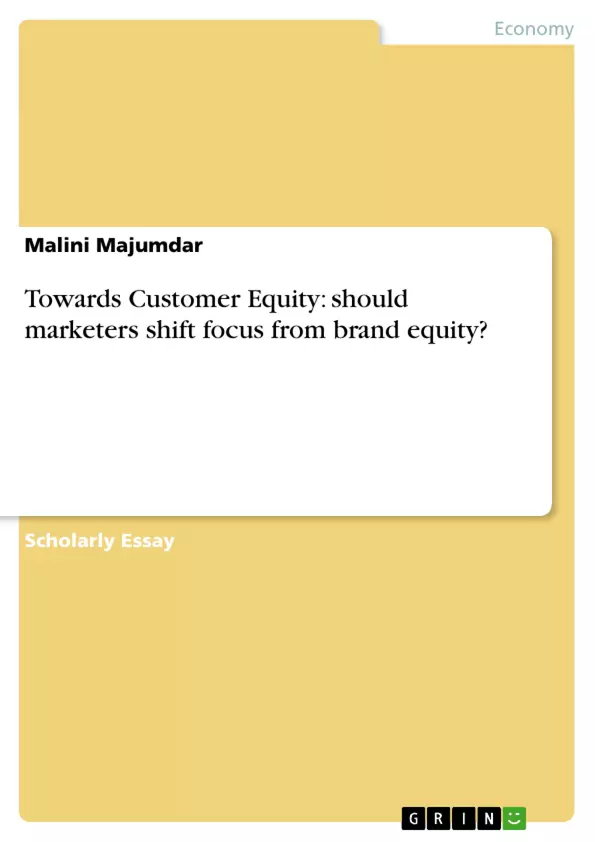A strong brand, having high brand equity generates higher revenue for the company. Brand Equity, as evidenced, results from a strong mental association that the customer links with the brand. It can be considered as the sum of customers’ assessments of a brand’s intangible qualities. Therefore, it cannot be a true measure of the marketing efforts of a company, though it was perceived so long to be so. Customer Equity, of late, has been identified as a basis to build powerful customer-centric marketing programs, which are more effective in highly competitive business scenario. There are three drivers of customer equity—value equity, brand equity, and relationship equity. Today's turbulent business environment is in requirement of maximizing the value of a company's customer assets. This stresses further the importance of focusing on Customer Equity as a customer-centric approach, rather than on Brand Equity, basically a product-centered approach.
Inhaltsverzeichnis (Table of Contents)
- Abstract
- Introduction
- Brand equity revisited
- Brand Equity from customer's point of view
- Customer based Brand equity (CBBE):
- Brand Identity:
- Brand Meaning:
- Brand Relationships:
- From Brand equity to Customer equity:
- A research evidence showing the importance of customer equity concept: (Clancy & Krieg: 2009)
- Why to focus so much on customer equity? Some evidences:
- Conclusion:
- References:
Zielsetzung und Themenschwerpunkte (Objectives and Key Themes)
This paper investigates the shift in marketing focus from brand equity to customer equity, exploring its potential benefits and implications for businesses. It aims to determine whether this shift represents a paradigm shift or a complementary approach to traditional brand equity strategies.
- Evolution of brand equity and its impact on customer perception
- The concept of customer equity and its three key drivers: value equity, brand equity, and relationship equity
- The argument for prioritizing customer equity in today's turbulent business environment
- Comparison of brand equity and customer equity approaches and their respective benefits
- The potential for a complementary approach that integrates both brand equity and customer equity strategies
Zusammenfassung der Kapitel (Chapter Summaries)
- Abstract: The paper introduces the concepts of brand equity and customer equity, emphasizing the growing importance of customer-centric marketing in today's competitive environment. It argues that customer equity, as a measure of the value of a company's customer assets, should be prioritized over traditional brand equity, a product-centric approach.
- Introduction: The introduction highlights the historical dominance of brand equity in marketing, emphasizing its role in building valuable and trustworthy brands. It acknowledges the shift in focus towards customer equity, driven by theories emphasizing the profitability of customer-centric strategies. The paper aims to explore this shift and its implications.
- Brand equity revisited: This chapter explores the concept of brand equity, defining it as the added value that a brand brings to its customers. It discusses the various perspectives on brand equity, highlighting its impact on customer perception, loyalty, and profitability. The chapter also discusses key indicators of brand equity, such as brand awareness, consideration set, and purchase decisions.
- Brand Equity from customer's point of view: This chapter explores the role of customer perception in building brand equity. It emphasizes the importance of strong mental associations, positive attitudes, and emotional connections that customers form with brands. The chapter discusses the role of brand awareness, recognition, and recall in shaping customer preferences.
- Customer based Brand equity (CBBE): This chapter delves into the Customer-Based Brand Equity (CBBE) model, which offers a framework for understanding the relationship between brand equity and customer value. It outlines the key elements of the CBBE model, including brand identity, brand meaning, and brand relationships.
Schlüsselwörter (Keywords)
The key focus topics and concepts in this paper include brand equity, customer equity, Customer-Based Brand Equity (CBBE) model, value equity, brand equity, relationship equity, customer-centric marketing, and product-centric marketing. The paper explores the shifting perspectives on brand and customer value in the context of contemporary business challenges and explores the potential for a more customer-centric approach to marketing.
- Arbeit zitieren
- Malini Majumdar (Autor:in), 2009, Towards Customer Equity: should marketers shift focus from brand equity?, München, GRIN Verlag, https://www.grin.com/document/138162



